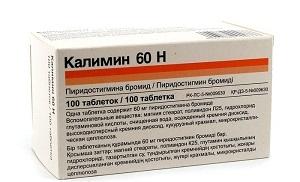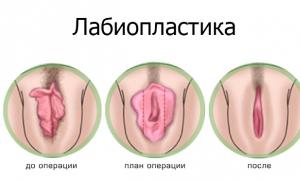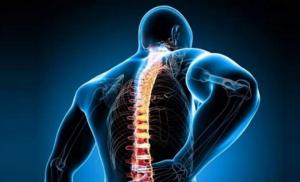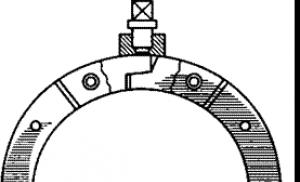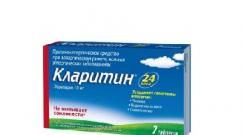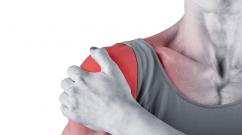ADHD tests for preschoolers research. ADHD Test for Adults
With the help of this test, parents and teachers will be able to make a primary conclusion about whether a particular child is showing signs of hyperactivity, and will also receive some recommendations on approaches to raising hyperactive children.
Criteria for hyperactivity (child observation scheme according to P. Baker and M. Alvord)
Active attention deficit:
1. Inconsistent, it is difficult for him to maintain attention for a long time.
2. Doesn't listen when spoken to.
3. He takes on a task with great enthusiasm, but never finishes it.
4. Experiences difficulties in organization.
5. Often loses things.
6. Avoids boring and mentally demanding tasks.
7. Often forgetful.
Motor disinhibition:
1. Constantly fidgets.
2. Shows signs of anxiety (drumming with fingers, moving in a chair, running, climbing somewhere).
3. Sleeps much less than other children, even in infancy.
4. Very talkative.
Impulsiveness:
1.
He begins to answer without finishing the question.
2. Unable to wait for his turn, often interferes and interrupts.
3. Poor concentration.
4. Cannot wait for reward (if there is a pause between action and reward).
5. Cannot control and regulate his actions. Behavior is poorly governed by rules.
6. When performing tasks, he behaves differently and shows very different results. (In some lessons the child is calm, in others he is not, in some lessons he is successful, in others he is not).
If at least six of the listed signs appear before the age of 7 years, the teacher can assume ( but do not make a diagnosis!) that the child he is observing is hyperactive. Responsibility for making a diagnosis can only be taken by a specialist: a psychologist or a neurologist. The teacher should only recommend in a tactful manner that parents contact these specialists for professional advice.
Often adults believe that a child is hyperactive only on the grounds that he moves a lot and is restless. This point of view is erroneous, since other manifestations of hyperactivity (deficit of active attention, impulsivity) are not taken into account in this case.
Especially often, teachers and parents do not pay due attention to the child’s manifestation of impulsiveness. What is impulsiveness? In the psychological dictionary this term is explained as follows:
« Impulsiveness- a feature of human behavior (in stable forms - a character trait), consisting in a tendency to act on the first impulse under the influence of external emotions. An impulsive person does not think about his actions, does not weigh the pros and cons, he reacts quickly and directly and often just as quickly repents of his actions.”
You can identify impulsivity using the “Signs of Impulsiveness” questionnaire. It was developed specifically for teachers and parents, does not contain special medical and psychological terms, and therefore will not cause difficulties in filling out and interpreting it.
Signs of impulsiveness
1. Always quickly finds an answer when asked about something (possibly the wrong one).
2. His mood often changes.
3. Many things irritate him and drive him crazy.
4. He likes work that can be done quickly.
5. Touchy, but not vindictive.
6. It often feels like he is tired of everything.
7. Makes decisions quickly and without hesitation.
8. May abruptly refuse food that he does not like.
9. Often distracted in class.
10. When one of the guys yells at him, he yells back.
11. Usually confident that he can cope with any task.
12. Can be rude to parents and teachers.
13. At times he seems to be brimming with energy.
14. This is a man of action, he does not know how to reason and does not like.
15. Requires attention and does not want to wait.
16. In games it does not obey general rules.
17. Gets excited during a conversation and often raises his voice.
18. Easily forgets instructions from elders and gets carried away with games.
19. Likes to organize and lead.
20. Praise and blame affect him more than others.
To obtain objective data, it is necessary for 2-3 adults who know the child well to assess his level of impulsiveness using this questionnaire. Then you need to sum up all the scores in all studies and find the average score.
A score of 15-20 points indicates high impulsiveness,
7-14 - about average,
A hyperactive child requires constant psychological support. Like other children, he wants to be successful in the things he undertakes, but more often than not he fails. Therefore, parents should think through all the instructions that they give to the child, and remember: the child will only do what is interesting to him, and will do it only until he gets bored. As soon as the child is tired, he should be switched to another activity.
It is also necessary to take care of the child’s workplace. It should be quiet and calm - not near the TV or constantly opening doors, but where the child could study without interference. While doing homework, it is advisable for parents to be nearby and, if necessary, help their restless son or daughter.
If a child is wrong about something, parents should not lecture him, since a long speech will not be fully listened to and understood. It is better to establish rules of behavior and a system of rewards and punishments in advance. As noted above, the requirements for the child must be specific, clear and feasible.
You cannot force a child to ask for forgiveness and make promises like this: “I will behave well,” “I will always obey you.” You can, for example, agree with your child that he “will not kick the cat” or “from today he will start putting his shoes in their place.” Each of these specific requirements can take a long time (two to four weeks or more) to complete. However, without working on one point, do not move on to the next. Be patient and try to finish what you started. Then it will be possible to achieve the fulfillment of another specific requirement.
The manifestations of ADHD are very diverse, but observation and diagnosis are carried out in three main areas: attention deficit and hyperactivity and impulsivity.
The American Psychiatric Association has developed criteria for diagnosing ADHD. According to the principles of the DSM-IV classification, published in 1994, there are three main forms of the syndrome: attention deficit hyperactivity disorder (ADHD/HD), attention deficit hyperactivity disorder with predominant attention disorder (ADHD/AD), and attention deficit hyperactivity disorder with predominant hyperactivity. and impulsivity (ADHD/H)-
When diagnosing, it should be remembered that all children are generally characterized by high physical activity. Children's attention becomes relatively stable by the age of 4-5 years. Preschool children are characterized by involuntary attention and poorly developed attention distribution. Younger schoolchildren have 2-3 times less attention span than adults. Children can maintain full attention during the lesson and during examination for no more than 12-15 minutes. In addition, it should be remembered that the process of maturation of the frontal structures in ontogenesis continues until 12-15 years. It should also be borne in mind that the syndrome occurs so often within the framework of mental retardation that it is not diagnosed as an independent pathology. To make a diagnosis, symptoms of ADHD must be followed for at least
6 months. Symptoms must appear before age 8 and be accompanied by psychological maladjustment. Only a doctor can make a diagnosis and determine an individual medication form of treatment. Psychological and neuropsychological correction can be carried out by appropriate specialists.
Diagnostic criteria for attention deficit hyperactivity disorder according to the DSM classification - IV.
A. To make a diagnosis, the following symptoms listed in sections 1 and 2 must be present:
1) Six or more of the following symptoms of inattentiveness that persist in the child for at least 6 months and are severe enough to indicate poor adaptation and nonconformity with normal age characteristics.
Attention deficit
1.Often unable to pay attention to details; due to negligence and frivolity, he makes mistakes in school assignments, in completed tasks and other activities.
Usually has difficulty maintaining attention when completing tasks or playing games.
Often it seems that the child is not listening to the speech addressed to him.
4 It often turns out to be unable to adhere to the proposed instructions and fully cope with lessons, homework or duties at the workplace (which has nothing to do with negative or protest behavior, inability to understand the task).
Often has difficulty organizing independent completion of tasks and other activities.
Typically avoids, expresses dissatisfaction with, and resists performing tasks that require prolonged mental stress
Often loses things needed at school and at home (for example, toys, school supplies, pencils, books, work tools).
Easily distracted by extraneous stimuli.
Often shows forgetfulness in everyday situations.
2) Six or more of the listed symptoms of hyperactivity and impulsivity, which persist in the child for at least six months and are so severe that they indicate insufficient adaptation and inadequacy
vii normal age characteristics.
1 responsiveness
1. Restless movements of the hands and feet are often observed; sitting on a chair, spinning, spinning.
Frequently gets up from his seat in the classroom during lessons or in other situations where he must remain seated.
Often exhibits aimless motor activity: runs, spins, tries to climb somewhere, and in situations where this is unacceptable.
Usually cannot play quietly, calmly, or do anything in his spare time.
He is often in constant motion and behaves “as if he had a motor attached to him.”
Often talkative.
And impulsiveness
Often answers questions without thinking, without listening to them to the end.
Usually has difficulty waiting his turn in various situations.
Often interferes with others, pesters others (for example, interferes with conversations or games).
B. Some symptoms of impulsivity, hyperactivity, and inattention begin to cause concern to others. children under 7 years of age.
C. Problems caused by the above symptoms occur in two or more areas surrounding both
new things (for example, at school and at home).
A. There is convincing evidence of clinically significant impairments in social contacts or school learning.
The most common methods for diagnosing attention are the methods of Schult, Anfilov-Krepilin, Toulouse-Pieron.
Toulouse test- Pierona
One of the psychophysiological methods for studying the properties of attention (concentration, stability, switchability), psychomotor tempo, volitional regulation, and the dynamics of performance over time is the Toulouse-Pieron test, which allows you to quickly and initially examine children 6 years of age and older. It is one of the variants of the “proofing” test, the general principle of which was developed by Bourdon in 1895. The essence of the task is to differentiate stimuli that are similar in formula and content over a long, precisely defined time. In relation to the problem under consideration in children with ADHD, it is possible to use a test to study attention and determine minimal brain dysfunction.
For students in grades 1-3, a simplified version of the method is used - 10 lines on a test form. The lines consist of various squares. The subject needs to find and cross out squares similar to the samples. Children must work with two types of sample squares (they are shown in the upper left corner of the form). Working time with one line - I minute,
Form
The examination can be carried out either in a group or individually. During group testing, children first listen to instructions, accompanied by a demonstration of sample squares. During the demonstration, sample squares and a part of the training line (at least 10 squares), necessarily containing all possible types of squares, are drawn on the chalkboard.
Instructions:"Attention! At the top left of your answer sheets are two sample squares. All other squares drawn on the form must be compared with them. The line located immediately below the samples and does not have a number is a training line (draft). On it you will now try how to complete the task. It is necessary to sequentially compare each square of the training line With samples. In the event that the square of the training line matches With any of the samples, it should be crossed out with one vertical line. If there is no such square among the samples, then it should be emphasized (the speaking of the instructions must be accompanied by a demonstration of the corresponding actions). Now you will sequentially process all the squares of the training
lines, crossing out those that match the patterns and underlining those that do not match. You must work strictly according to the instructions. It is forbidden:
1. First cross out all the squares that match the samples, and then underline the remaining ones.
2. Limit yourself to only crossing out squares.
Underline with a solid line if there are squares in a row that do not match the patterns.
Follow the instructions in reverse: underline the squares that match and cross out the squares that do not match the patterns.”
Only after the children have understood everything can they begin to independently process the training lines on their forms. Those who do not understand must be shown individually on a form how to work. Such children usually include kinesthetic learners, for whom verbal-visual instructions are not enough, as well as children with mild parietal or frontal organicity. To understand, they need to practically try out the work under the supervision of an adult. Children with mild frontal organics are, in principle, unable to perform inverted actions, so they cross out the squares that do not match the patterns and underline the ones that match, i.e. They act according to the logic of “remove what is not similar”, but cannot work according to the instructions. Difficulties in working with parietal pathology are associated with impaired visual-motor coordination, for the diagnosis of which the Bender graphic test can be used.
When performing the test, it is necessary to ensure that all children, while underlining and crossing out, change the orientation of their movements from horizontal to vertical. To simplify the work, children may unconsciously bring horizontal and vertical lines closer to each other.
Continuation of the instructions: “Now we will all work together and exactly on time. Each line is given 1 minute. On the command "Stop!" you need to move on to processing the next line. No matter where the signal finds you, you must immediately move your hand to the next line and continue working without interruption. We need to work as quickly as possible and as carefully as possible.”
The examination results are processed by placing a key made of transparent material on the form. On the key, the markers highlight the places within which the crossed out squares should appear. Outside the markers, all squares must be underlined.
For each line the following is calculated:
The total number of squares processed (including errors).
Number of mistakes.
Incorrect processing, corrections and omissions are considered an error. Then the values are transferred to the Results Record Form.
The main calculated indicators for children with ADHD include test accuracy rate(an indicator of concentration) and indicator of attention stability.
1. Test execution speed:

Where P- number of working lines;
X, - the number of processed characters in the line.
Thus, the total amount of processed characters is divided by the number of working lines.
2. Test execution accuracy rate (or indicator of concentration):

And
Where V - speed;
A- average number of errors per line.
P- number of working lines.
y,- the number of errors in the line. This is the ratio of correctly processed characters to the total number of processed characters 3. Sustainability of attention:

Where P- number of working lines: y,- number of errors in the line. A - average number of errors per line
Age standards for the speed of performing the Toulouse-Pieron test
|
Age groups |
Execution speed (VI |
||||
|
Pathology |
Age norm | ||||
|
6- 7 years |
40 and > |
||||
|
1st Class |
45 and > |
||||
|
2nd Class |
58 and > |
||||
|
3rd Class |
49 and > |
||||
Age standards for the accuracy of the Toulouse-Pieron test
|
Execution accuracy (TO) |
|||||
|
Age groups |
Pathology |
Age | |||
|
6 -7 years |
0.98-1.0 |
||||
|
1st-2nd classes |
0,89 And< |
0,90 0,91 |
0.92 0,95 |
0,96 0,97 |
0.98-1.0 |
|
3rd Class |
0.97-1.0 |
||||
If the calculated value of the test accuracy indicator falls into the pathology zone, then the probability of MMD is extremely high. In this case, the child must be referred to a neurologist. If the calculated indicator is in the zone of weak development of attention accuracy, then it is necessary to additionally analyze the speed of performing the Toulouse-Pieron test. If the speed value falls into the zone of pathology or low level, then MMD is also quite likely. However, the final diagnosis is made by a neurologist. We can talk about the complete disappearance of MMD only when the accuracy and speed indicators reach the level of the age norm.
The accuracy of test performance (K) is associated with concentration, but may also depend on the following characteristics: switching of attention, attention span, working memory, visual thinking, personal characteristics.
The predominance of errors at the beginning and end of a line indicates a violation of attention switching. If errors increase in proportion to the distance from the samples, i.e. As you move to the right and down on the response form, the volumetric characteristics of attention are disrupted and the field of attention is narrowed. Dropouts or substitution of samples are typical for weakened working memory. Errors associated with the simultaneous crossing out of squares, both corresponding to the samples and those. which are mirrored or symmetrical about the vertical axis. indicate deficiencies in visual thinking and analysis, as well as an unformed separation of right-left orientation. Such errors are also typical for retrained left-handers.
The ability to voluntarily concentrate attention can only be formed as the functioning of the brain normalizes. Sustainability of attention is associated with the development of volition and the ability for volitional regulation.
Children with elements of autism in their behavior understand instructions well and remember them for several days, and also correctly process the training line. However, further execution of the program is disrupted. They can rhythmically alternate between crossing out and underlining, drawing a 1 or a checkmark in each square, etc. This is only possible for them in a group; such things do not happen one on one with an experimenter.
Please confirm that the training and/or tests are for you. You will create a personal account. This type of account is designed specifically to help you evaluate and train your cognitive abilities.
Confirm that you would like to offer cognitive training and/or testing to your family or friends. You will create a family account. This account has been created to give your family access to CogniFit tests and workouts.
Computerized Test Battery to Identify the Risk Index for the Presence of ADHD
- Assess the risk index for the presence of ADHD
- For children over 7 years old, youth and adults
- The test duration is approximately 30-40 minutes
- Test Reliability Analysis - English only
The Computerized Assessment Battery for ADHD (CAB-ADHD) from CogniFit is a professional, market-leading tool consisting of a series of validated clinical tests and tasks that help quickly and accurately determine the presence of symptoms. signs and disturbances of cognitive processes characteristic of Attention Deficit Disorder with or without Hyperactivity.
This innovative online ADHD test is a scientific resource that allows you to conduct a comprehensive cognitive screening, identify weak and strong cognitive skills and evaluate the risk index the presence of Attention Deficit Disorder with or without Hyperactivity, and also determine the subtype of the disorder: dominant inattentive (ADD), dominant hyperactive-impulsive or combined (ADHD). The test is intended for children over 7 years old, youth and adults. Any user, both private and professional, can easily use this neuropsychological testing battery.
The results report becomes automatically available after the completion of the test, the passing of which takes approximately 30-40 minutes.
Diagnosis of Attention Deficit Disorder with or without Hyperactivity Disorder (ADHD) requires extensive testing and careful differential diagnosis to rule out the possibility that presenting symptoms and dysfunction may be caused by mood, learning and developmental disorders, or other pathologies.
Clinical history and various testing, especially neuropsychological testing, remain the most effective tools for diagnosing Attention Deficit Disorder with or without Hyperactivity Disorder. Please note that CogniFit does not offer medical diagnosis for ADD/ADHD. It is recommended that this comprehensive ADHD test be used as an adjunct to professional diagnosis. This test cannot replace a clinical interview.
Digital Protocol for ADHD Test (CAB-ADHD)
This comprehensive cognitive assessment for the detection of Attention Deficit Disorder with or without Hyperactivity Disorder consists of a questionnaire and a comprehensive battery of neuropsychological tests. Its duration is about 30-40 minutes.
An adult or child with suspected ADHD must answer a questionnaire that assesses age-specific clinical symptoms and signs, and then complete a series of validated exercises and tasks presented in the form of simple computer games.
Questionnaire developed based on diagnostic criteria
The test is a series of simple answer questions designed to identify the major diagnostic criteria (DSM-5) signs and symptoms of ADHD. The questionnaire contains screening tests adapted to the user's age.
Neuropsychological factors and cognitive profile
The battery of tasks is designed to assess the basic neuropsychological factors identified in the scientific literature as criteria for this disorder. A special role is given to indicators of executive functions. Clinical scales and tests are used that are validated for the age of the user.
Full results report
Upon completion of the ADHD test, you will receive a detailed results report, which will reflect the risk index for the presence of the disorder (low-medium-high), which will also allow you to determine the typology of the syndrome (ADD, Hyperactivity or ADHD), warning signs and symptoms, cognitive profile , analysis of results, tips and recommendations. Test results provide valuable information that can help develop correction methods.
Psychometric results
Psychometric results
The Attention Deficit Disorder with or Without Hyperactivity Disorder (CAB-ADHD) test from CogniFit uses patented algorithms and artificial intelligence (AI) technology to analyze over a thousand variables and tell you, through accurate psychometric results, whether you are at risk for ADD. or ADHD.
The cognitive profile presented in the neuropsychological report is highly reliable, stable and consistent. The test results are confirmed through repeated tests and measurements. To confirm the reliability, various methods were used, including the Cronbach Alpha coefficient, the value of which is about 9. The test-retest reliability of the test (Test-Retest) is about 1, which indicates high accuracy and reliability.
Who is the program intended for?
The test battery (CAB-ADHD) is suitable for children over 7 years of age and adults who are suspected of having Attention Deficit Disorder with or without Hyperactivity. Any user, both private and professional, can easily administer this neuropsychological testing battery. No special knowledge of neuroscience or computer science is required to use this clinical program. Testing is intended mainly for:
Health professionals
Conduct accurate testing of my patients and provide a full report of the results
The CogniFit Neuropsychological Testing Battery for ADHD assists healthcare professionals in detection, diagnosis and intervention. Identifying symptoms and cognitive dysfunction is the first step to detect Attention Deficit Disorder with or without Hyperactivity Disorder, correct diagnosis and further neuropsychological intervention. With this powerful patient management software, you can examine numerous metrics and provide comprehensive and personalized reports.
Schools and teaching staff
Identify students who are at risk of developing ADHD. Help prevent school failure and social problems
This battery of neuropsychological assessments, presented in the form of simple tests, allows teachers and educators not specializing in the field of Attention Deficit Disorder with or without Hyperactivity Disorder to objectively assess students and create comprehensive, personalized reports to assess their strengths and weaknesses and quickly identify students at risk of having ADD or ADHD who require individual assessment and instruction on a compensatory basis.
Parents, guardians and individuals
Find out if people close to me are at risk of developing ADHD
The ADHD Test is a scientifically developed resource consisting of simple and fun tests and activities that can be completed online. It allows any user without specialized knowledge to assess various neuropsychological factors associated with Attention Deficit Disorder with or without Hyperactivity Disorder. A comprehensive system of results makes it possible to determine whether there is a risk of having a given disorder and what its subtype is (ADD, Hyperactivity or ADHD), and provides recommendations in each specific case.
Advantages
Advantages
There are many benefits to using this scientifically developed software to quickly and accurately assess the signs, symptoms, weaknesses, strengths and dysfunctions of cognitive processes impaired due to Attention Deficit Disorder with or without Hyperactivity Disorder:
TOOL LEADER
CogniFit's Cognitive Assessment Battery for ADHD (CAB-ADHD) is a professional resource created by experts in the field of childhood-onset neurobiological disorders. Cognitive tests are patented and clinically validated. This industry-leading tool is widely used by the scientific community, schools, universities, families, associations, foundations and medical centers around the world.
EASY TO USE
Any private or professional user (health specialist, teacher, etc.) can independently administer the neuropsychological testing battery without having special knowledge in the field of neuroscience or computer science. The interactive format allows you to easily and effectively manage the program.
HIGH ATTRACTIVENESS
All clinical exercises are automatically presented in the form of fun, interactive games, which increases motivation and ease of understanding when performing them, especially for children.
DETAILED RESULT REPORT
The Cognitive Assessment Battery for ADHD (CAB-ADHD) provides rapid and accurate feedback through a comprehensive performance analysis system to identify and understand clinical symptoms, strengths and weaknesses, risk index, typology and disorder subtype (ADD, Hyperactivity or ADHD) .
This powerful program analyzes over a thousand variables and offers specific recommendations for each disorder subtype (ADD, Hyperactivity or ADHD) and each user's needs.
This battery of tests can reliably detect a person's risk of ADD, Hyperactivity or ADHD. adults and children over 7 years old.
It is recommended to undergo this test as soon as possible if there is a suspicion of Attention Deficit Disorder with or without Hyperactivity. Early detection will allow developmental difficulties to be minimized and an appropriate intervention program to be implemented.
This battery of neuropsychological tests can also identify the risk of the disorder in adults. Currently, many adults who have experienced problems with attention, concentration and impulsivity, increased activity, and difficulty following directions and routine tasks throughout their lives are not even aware of the presence of this dysfunction. And despite having normal and often above average intellectual abilities, it is very likely that they were considered lazy, absent-minded, problematic, brash, aggressive or underachieving.
If the problem is not detected in time and the necessary measures are not taken, it can lead to difficulties in everyday life, at work or school, in social, family and emotional spheres.
ADHD is associated with difficulties and delays in academic, work and social areas. This syndrome affects behavior and is characterized by moderate to severe distractibility, short periods of attention, motor restlessness, emotional instability, and impulsive behavior.
Subtypes of ADHD
Most important symptoms
Description
Dominant inattentive
Difficulty concentrating and maintaining attention on a stimulus
Children and adults with Attention Deficit Disorder (ADD) experience severe problems with attention, but little or no hyperactivity. Moreover, this subtype is characterized by slowness and hypoactivity. Difficulties with attention are associated with reduced functional activity and insufficient development of the prefrontal cortex, which does not allow for the correct processing of information and the activation of neural mechanisms necessary for understanding, initiating and correctly implementing an action, as well as for avoiding distraction. It is very common for people with ADD to become distracted by noise or activity, fail to pay attention to details, make mistakes, or become careless when performing boring or difficult tasks (school assignments, work assignments, etc.)
Inability to listen and follow a conversation
Children and adults with Attention Deficit Disorder (ADD) have difficulty perceiving, processing, and concentrating on received stimuli. Therefore, when you talk to them, you get the impression that they are not listening. They have difficulty concentrating on what another person is saying and find it very difficult to maintain proper behavior in class, at work, or at home. They also have difficulty following directions when completing a task or project.
Maladaptive behavior and dysfunctional adaptation to the social environment
Lack of attention and impairments in cognitive processes in people with ADD make it difficult to correctly understand social interactions and apply the rules and norms that govern them. Problems with understanding established norms and following them in some cases can provoke inappropriate reactions and difficulties in adapting to the environment (family, school, social relationships, sports, romantic relationships, etc.), which can lead to rejection, low self-esteem, inappropriate attention-seeking behavior, withdrawal, irritability, and decreased performance at school or productivity at work.
They often lose things and forget about things to do
Often people suffering from this disorder lose things or forget what they need for their activities (toys, school or work supplies, tools, etc.). They are easily distracted and seem forgetful. They don't remember where they left their jacket, where they put the money, they forget about their responsibilities, work meetings and other important things.
"Low motivation" when completing a task
Very often, such people have problems organizing and completing affairs and tasks. This is because children and adults with ADHD have difficulty focusing their attention on a specific activity. This "lack of motivation" has nothing to do with the person being lazy or not understanding directions. This simply means that his brain has a harder time suppressing external stimuli and focusing on just one activity. Therefore, people with ADD show poor performance on repetitive or routine tasks. They find it difficult to follow instructions to the end and often give up what they started. They try to avoid tasks that require constant mental effort or a lot of thinking (school exercises, tasks that require attention, household chores, etc.).
Mood changes and symptoms of anxiety and low self-esteem
These symptoms may develop as a consequence of failure to adapt and rejection. Very often they feel misunderstood by their comrades, worse than others.
Dominant hyperactive-impulsive
Their actions can be dangerous
Problem with self-control or inability to inhibit behavior
Children and adults with the dominant hyperactive-impulsive subtype of ADHD are spontaneous. Therefore, it is difficult for them to control not only their behavior, but also their thoughts and emotions.
They are very impetuous and speak and act without thinking.
They find it difficult to imagine the consequences of their actions or analyze the situation in detail. Therefore, they often speak or act inappropriately.
Lack of planning in daily activities
This impulsiveness can lead them to frustration, in other words, they are constantly disappointed because the expected and received results do not match.
Poor productivity at school or work
They find it difficult to adapt to norms. Their productivity is closely tied to a lack of self-control, which leads them to quit boring tasks for which they are not compensated.
Difficulty making friends and maintaining relationships
As a rule, children and adults with a dominant hyperactive-impulsive subtype of ADHD have difficulty maintaining relationships and adjusting to their environment (at school, at work, in the family, in social relationships and relationships with a partner, etc.). Their impulsiveness and brash behavior can often cause rejection in other people.
They don't know how to lose at games or sports.
In some cases, they easily get into fights. This happens because their brain has difficulty analyzing the situation and anticipating the consequences.
Their actions can be dangerous
Often they are not aware of how dangerous or risky their actions may be.
They seem to be in constant motion
Hyperactivity is an excessive behavior characterized by increased motor activity, such people have difficulty staying still. They need more movement than their comrades and behave inappropriately.
Constant unconscious movements of arms and legs
Unconscious movements, such as swaying, constant moving from place to place.
Trouble starting a task
Even when they find it exciting.
They tend to interfere in other people's affairs and conversations
They may behave inappropriately, saying or doing things that are not appropriate.
They lack patience and are unable to complete tasks that require attention or calmness
Hyperactivity is more of an overactive behavior and it means that it is excessive, uncontrollable, there are problems with motor coordination due to neurological reasons.
Combined
Show combined symptoms of inattention and hyperactivity-impulsivity
Problems with concentration and perception of stimuli. Mood changes and anxiety symptoms, low self-esteem. Problems with self-control and inability to inhibit behavior. They are hasty, act or speak without thinking. Lack of planning in daily activities.
Description of the diagnostic criteria-based questionnaire
ADHD and its subtypes are characterized by a series of clinical symptoms and signs. They may indicate the presence of this disorder. Therefore, the first step in administering the Attention Deficit Disorder with or without Hyperactivity Disorder (CAB-ADHD) Battery is to complete a questionnaire with screening tests based on key diagnostic criteria, signs and symptoms of ADHD appropriate for each age.
The questionnaire questions are similar to those found in a diagnostic manual, clinical questionnaire, or test scales, but they are simplified so that almost anyone can answer them.
Diagnostic criteria for children from 7 to 12 years old
Consist of a series of simple questions, the answers to which must be completed by the curator or specialist responsible for testing. The questionnaire includes questions in areas such as: hyperactivity and impulsivity (is it difficult to control movement and is able to stop behavior), inattention or inattentiveness (can maintain attention for the time required to complete a task), problems in social relationships (frustration, low self-esteem), training and development (education, insufficient acquisition of educational knowledge).
Diagnostic criteria for adolescents from 13 to 17 years old
Consists of a series of simple questions that must be completed by the supervisor or family member responsible for testing. The questionnaire includes questions in areas such as: hyperactivity and impulsivity (feelings of inner restlessness, impatience), inattention or lack of attention (distractibility, difficulty concentrating), social skills deficits (lack of empathy, assertiveness), learning and development (problems with learning, school problems). failure, etc.).
Diagnostic criteria for adults
Consists of a series of simple questions that can be completed by either the professional or the person taking the ADHD test. The questionnaire includes questions in such areas as: hyperactivity and impulsivity (overworked, impulsive, quick loss of control), inattention (disorganized, problems completing projects), academic performance (problems with studies), difficulties in social-work interaction (problems with adaptation) .
Description of a test battery to assess neuropsychological factors associated with ADHD
The presence of impairments in any cognitive abilities may indicate ADHD. The overall profile of cognitive abilities can give us an idea of the subtype of ADHD and the intensity of the impairment associated with this disorder.
Problems with hyperactivity, impulsivity, inattention, difficulties in social relationships, problems with school or work are associated with deficits in various cognitive abilities. The Assessment of ADHD (CAB-ADHD) tests these cognitive areas and abilities.
Cognitive domains tested
Cognitive abilities
Attention
The ability to avoid distractions and concentrate on important information.
8.4% above average result
Focused Attention
Focused attention and ADHD. Focused attention is the ability to maintain the focus of attention on a target stimulus, regardless of the duration of this fixation. People with ADHD often have difficulty focusing their attention on stimuli and events that are important and meaningful in any given situation. This can lead, for example, to losing important information in class.
569 Your points
400
Inhibition
Inhibitory control and ADHD. Inhibition is the ability to inhibit or control impulsive (or automatic) responses and generate responses through reasoning and attention. Deficits in inhibitory control can trigger impulsive and repetitive behavior, which can lead the person with ADHD to engage in dangerous and inappropriate behavior.
567 Your points
400 Average for your age
The ability to retain and manage new information and to retrieve memories.
7.5% above average result
Short-term memory
Short-term memory and ADHD. Short-term memory is the ability to retain a small amount of information for a short period of time. Problems with short-term memory can prevent us from understanding what is being explained to us or what we are reading because the information is not retained.
594 Your points
400 Average for your age
Criteria for hyperactivity (child observation scheme according to P. Baker and M. Alvord)
Active attention deficit:
1. Inconsistent, it is difficult for him to maintain attention for a long time.
2. Doesn't listen when spoken to.
3. Takes on a task with great enthusiasm, but never finishes it.
4. Experiences difficulties in organization.
5. Often loses things.
6. Avoids boring and mentally demanding tasks.
7. Is often forgetful.
Motor disinhibition:
1. Constantly fidgets.
2. Shows signs of anxiety (drumming with fingers, moving in a chair, running, climbing somewhere).
3. Sleeps much less than other children, even in infancy.
4. Very talkative.
Impulsiveness:
1. Starts to answer without finishing the question.
2. Unable to wait for his turn, often interferes and interrupts.
3. Poor concentration.
4. Cannot wait for a reward (if there is a pause between the action and the reward).
5. Cannot control and regulate his actions. Behavior is poorly governed by rules.
6. When performing tasks, he behaves differently and shows very different results. (In some lessons the child is calm, in others he is not, in some lessons he is successful, in others he is not).
If at least six of the listed signs appear before the age of 7 years, the teacher can assume (but not make a diagnosis!) that the child he is observing is hyperactive.
Very often, teachers ask themselves the question: “What to do if a child shows signs of hyperactivity? There is no diagnosis in the medical record, and parents do not attach importance to the problems that have arisen, hoping that everything will go away with age.”
In this case, the teacher can tactfully recommend that parents contact a specialist: a psychologist or neurologist. Agree that the doctor should take responsibility for making the diagnosis. It is important to convince parents that the child needs specialist help.
Often adults believe that a child is hyperactive only on the grounds that he moves a lot and is restless. This point of view is erroneous, since other manifestations of hyperactivity (deficit of active attention, impulsivity) are not taken into account in this case. Especially often, teachers and parents do not pay due attention to the child’s manifestation of impulsiveness. What is impulsiveness? In the psychological dictionary, this term is explained as follows: “Impulsivity is a feature of human behavior (in stable forms - a character trait), consisting in a tendency to act on the first impulse under the influence of external emotions. An impulsive person does not think about his actions, does not weigh the pros and cons, he reacts quickly and directly and often just as quickly repents of his actions.” You can identify impulsivity using the “Signs of Impulsiveness” questionnaire. It is designed for teachers, does not contain special medical and psychological terms, and therefore will not cause difficulties in filling out and interpreting it.
Signs of impulsivity (questionnaire)
Impulsive child:
1. Always quickly finds an answer when asked about something (possibly the wrong one).
2. His mood often changes.
3. Many things irritate him and make him angry.
4. He likes work that can be done quickly.
5. Touchy, but not vindictive.
6. He often feels that he is tired of everything.
7. Makes decisions quickly and without hesitation.
8. May abruptly refuse food that he does not like.
9. Often gets distracted in class.
10. When one of the guys shouts at him, he shouts back.
11. I am usually confident that I can cope with any task.
12. Can be rude to parents and teachers.
13. At times he seems to be full of energy.
14. This is a man of action, he does not know how to reason and does not like.
15. Demands attention, does not want to wait.
16. Does not follow general rules in games.
17. Gets excited during a conversation and often raises his voice.
18. Easily forgets instructions from elders and gets carried away with games.
19. Likes to organize and lead.
20. Praise and blame affect him more than others.
To obtain objective data, it is necessary for 2-3 adults who know the child well to assess his level of impulsiveness using this questionnaire. Then you need to sum up all the scores in all studies and find the average score. A score of 15-20 points indicates high impulsiveness, 7-14 - average, 1-6 points - low.
A hyperactive child requires constant psychological support. Like other children, he wants to be successful in the things he undertakes, but more often than not he fails. Therefore, parents should think through all the instructions that they give to the child, and remember: the child will only do what is interesting to him, and will do it only until he gets bored. As soon as the child is tired, he should be switched to another activity.
It is also necessary to take care of the child’s workplace. It should be quiet and calm - not near the TV or constantly opening doors, but where the child could study without interference. While doing homework, it is advisable for parents to be nearby and, if necessary, help their restless son or daughter.
If a child is wrong about something, parents should not lecture him, since a long speech will not be fully listened to and understood. It is better to establish rules of behavior and a system of rewards and punishments in advance. As noted above, the requirements for the child must be specific, clear and feasible.
You cannot force a child to ask for forgiveness and make promises: “I will behave well,” “I will always obey you.” You can, for example, agree with your child that he “will not kick the cat” or “from today he will start putting his shoes in their place.” Each of these specific requirements can take a long time (two to four weeks or more) to complete. However, without working on one point, do not move on to the next. Be patient and try to finish what you started. Then it will be possible to achieve the fulfillment of another specific requirement.
Attention deficit disorder, hyperactivity, impulsivity
I. Symptoms of inattention that have persisted in the child for at least 6 months and are severe enough to indicate maladjustment and failure to meet normal developmental characteristics (six or more of the following symptoms must be present):
1. Often unable to pay attention to details;
due to negligence and frivolity, he makes mistakes in school assignments, work and other activities.
2. Usually has difficulty maintaining attention when completing tasks or playing games.
3. Often one gets the impression that the child does not listen to the message addressed to him.
speech to him.
4. Often fails to follow suggested instructions and complete lessons, homework, or work responsibilities (which has nothing to do with negative or
protest behavior, inability to understand the task).
5. Often has difficulty organizing independent work
assignments and other activities.
6. Usually avoids, expresses dissatisfaction with, and resists involvement in tasks that require long-term mental stress (for example, school assignments, homework).
7. Often loses things needed at school and at home (for example, toys, school supplies, pencils, books, work tools).
8. Easily distracted by extraneous stimuli.
9. Is often forgetful in everyday situations.
II. Symptoms of hyperactivity and impulsivity that persist for
for at least 6 months and are so pronounced that they indicate insufficient adaptation and non-compliance with normal
age characteristics (six or more of the following symptoms must be present):
Hyperactivity
1. Restless movements in the hands and feet are often observed; sitting on a chair, spinning, spinning.
2. Frequently gets up from his seat in class during lessons or in other situations where he must remain seated.
3. Often exhibits aimless motor activity: running, spinning,
trying to get into something, and in situations where this is unacceptable.
4. Usually cannot play quietly or quietly or do leisure activities.
5. Is often in constant motion and behaves “as if he had a motor attached to him.”2
6. Is often talkative.
Impulsiveness
1. Often answers questions without thinking, without listening to them completely.
2. Usually has difficulty waiting his turn in various situations.
3. Often interferes with others, pesters others (for example, interferes in
conversations or games).
Child anxiety test
Lavrentva G. P., Titarenko T. M., 1992
1. Cannot work for a long time without getting tired.
2. It is difficult for him to concentrate on something.
3. Any task causes unnecessary anxiety.
4. While performing tasks, he is very tense and constrained.
5. Feels embarrassed more often than others.
6. Often talks about tense situations.
7. As a rule, blushes in unfamiliar surroundings.
8. Complains that he has terrible dreams.
9. His hands are usually cold and wet.
10. He often has upset bowel movements.
11. Sweats a lot when excited.
12. Doesn't have a good appetite.
13. Sleeps restlessly and has difficulty falling asleep.
14. He is timid and fears many things.
15. Usually restless and easily upset.
16. Often cannot hold back tears.
17. Does not tolerate waiting well.
18. Doesn't like to take on new things.
19. I am not confident in myself, in my abilities.
20. Afraid to face difficulties.
Add up the number of positives to get a total anxiety score.
High anxiety - 15-20 points
Average - 7-14 points
Low - 1-6 points.
Preview:
How to identify a hyperactive child?
Criteria for hyperactivity
(child observation scheme according to P. Baker and M. Alvord)
Active attention deficit:
1. Inconsistent, it is difficult for him to maintain attention for a long time.
2. Doesn't listen when spoken to.
3. Takes on a task with great enthusiasm, but never finishes it.
4. Experiences difficulties in organization.
5. Often loses things.
6. Avoids boring and mentally demanding tasks.
7. Is often forgetful.
Motor disinhibition:
1. Constantly fidgets.
2. Shows signs of anxiety (drumming with fingers, moving in a chair, running, climbing somewhere).
3. Sleeps much less than other children, even in infancy.
4. Very talkative.
Impulsiveness:
1. Starts to answer without finishing the question.
2. Unable to wait for his turn, often interferes and interrupts.
3. Poor concentration.
4. Cannot wait for a reward (if there is a pause between the action and the reward).
5. Cannot control and regulate his actions. Behavior is poorly governed by rules.
6. When performing tasks, he behaves differently and shows very different results. (In some lessons the child is calm, in others he is not, in some lessons he is successful, in others he is not).
If at least six of the listed signs appear before the age of 7 years, the teacher can assume (but not make a diagnosis!) that the child he is observing is hyperactive.
Very often, teachers ask themselves the question: “What to do if a child shows signs of hyperactivity? There is no diagnosis in the medical record, and parents do not attach importance to the problems that have arisen, hoping that everything will go away with age.”
In this case, the teacher can tactfully recommend that parents contact a specialist: a psychologist or neurologist. Agree that the doctor should take responsibility for making the diagnosis. It is important to convince parents that the child needs specialist help.
Often adults believe that a child is hyperactive only on the grounds that he moves a lot and is restless. This point of view is erroneous, since other manifestations of hyperactivity (deficit of active attention, impulsivity) are not taken into account in this case. Especially often, teachers and parents do not pay due attention to the child’s manifestation of impulsiveness. What is impulsiveness? In the psychological dictionary, this term is explained as follows: “Impulsivity is a feature of human behavior (in stable forms - a character trait), consisting in a tendency to act on the first impulse under the influence of external emotions. An impulsive person does not think about his actions, does not weigh the pros and cons, he reacts quickly and directly and often just as quickly repents of his actions.” You can identify impulsivity using the “Signs of Impulsiveness” questionnaire. It is designed for teachers, does not contain special medical and psychological terms, and therefore will not cause difficulties in filling out and interpreting it.
Signs of impulsivity (questionnaire)
Impulsive child:
1. Always quickly finds an answer when asked about something (possibly the wrong one).
2. His mood often changes.
3. Many things irritate him and make him angry.
4. He likes work that can be done quickly.
5. Touchy, but not vindictive.
6. He often feels that he is tired of everything.
7. Makes decisions quickly and without hesitation.
8. May abruptly refuse food that he does not like.
9. Often gets distracted in class.
10. When one of the guys shouts at him, he shouts back.
11. I am usually confident that I can cope with any task.
12. Can be rude to parents and teachers.
13. At times he seems to be full of energy.
14. This is a man of action, he does not know how to reason and does not like.
15. Demands attention, does not want to wait.
16. Does not follow general rules in games.
17. Gets excited during a conversation and often raises his voice.
18. Easily forgets instructions from elders and gets carried away with games.
19. Likes to organize and lead.
20. Praise and blame affect him more than others.
To obtain objective data, it is necessary for 2-3 adults who know the child well to assess his level of impulsiveness using this questionnaire. Then you need to sum up all the scores in all studies and find the average score. A score of 15-20 points indicates high impulsiveness, 7-14 - average, 1-6 points - low.
A hyperactive child requires constant psychological support. Like other children, he wants to be successful in the things he undertakes, but more often than not he fails. Therefore, parents should think through all the instructions that they give to the child, and remember: the child will only do what is interesting to him, and will do it only until he gets bored. As soon as the child is tired, he should be switched to another activity.
It is also necessary to take care of the child’s workplace. It should be quiet and calm - not near the TV or constantly opening doors, but where the child could study without interference. While doing homework, it is advisable for parents to be nearby and, if necessary, help their restless son or daughter.
If a child is wrong about something, parents should not lecture him, since a long speech will not be fully listened to and understood. It is better to establish rules of behavior and a system of rewards and punishments in advance. As noted above, the requirements for the child must be specific, clear and feasible.
You cannot force a child to ask for forgiveness and make promises: “I will behave well,” “I will always obey you.” You can, for example, agree with your child that he “will not kick the cat” or “from today he will start putting his shoes in their place.” Each of these specific requirements can take a long time (two to four weeks or more) to complete. However, without working on one point, do not move on to the next. Be patient and try to finish what you started. Then it will be possible to achieve the fulfillment of another specific requirement.
